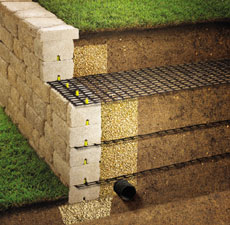| Follow installation guidelines for construction of segmental retaining walls per the manufacturer’s recommendations. In preparation for installing geogrid, make sure unit drainage fill is placed at least 1 foot behind units, backfill soils are compacted and retaining wall units are swept clean. For best compaction results use vibratory plate compactor with sand or granular soils, or a jumping jack compactor with clay soils. If these tools are not available, a manual hand tamper may be used as an alternative. |
|
Refer to design charts for proper placement and length of geogrid. If geogrid length by design is longer than 4 feet, then geogrid should be rolled out and cut to specified length. Place front edge of geogrid within 2 inches of the front face of the retaining wall units and lay flat on compacted fill. Make sure compacted fill area is level and at the same elevation as the last course of retaining wall units. For walls with radius geometry, geogrid should be cut in sections to remain perpendicular to wall face. |
|
Place next row of retaining wall units on geogrid and secure units in proper alignment position. Pull geogrid taut to eliminate loose folds. Place back fill material on geogrid taking care not to wrinkle or create folds. Keep back fill lifts 6 to 8 inches in depth to ensure proper compaction of soil. |





